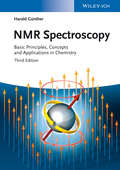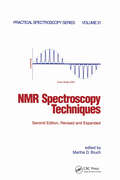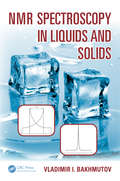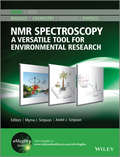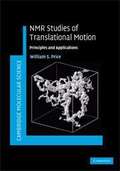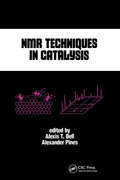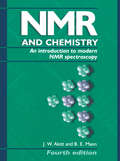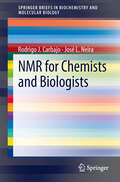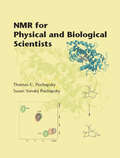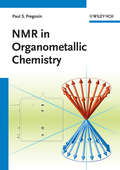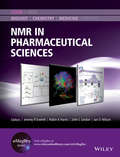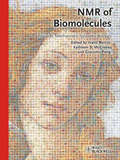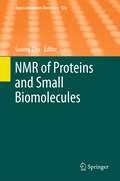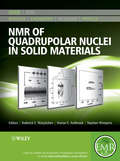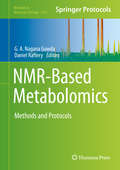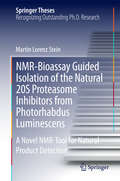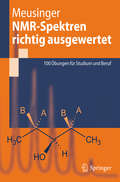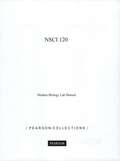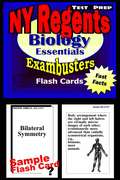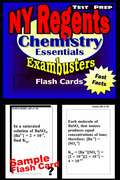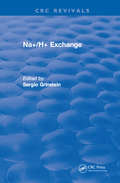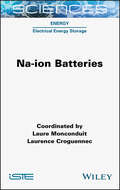- Table View
- List View
NMR Spectroscopy
by Harald GüntherNuclear magnetic resonance (NMR) spectroscopy is one of the most powerful and widely used techniques in chemical research for investigating structures and dynamics of molecules. Advanced methods can even be utilized for structure determinations of biopolymers, for example proteins or nucleic acids. NMR is also used in medicine for magnetic resonance imaging (MRI). The method is based on spectral lines of different atomic nuclei that are excited when a strong magnetic field and a radiofrequency transmitter are applied. The method is very sensitive to the features of molecular structure because also the neighboring atoms influence the signals from individual nuclei and this isimportant for determining the 3D-structure of molecules.This new edition of the popular classic has a clear style and a highly practical, mostly non-mathematical approach. Many examples are taken from organic and organometallic chemistry, making this book an invaluable guide to undergraduate and graduate students of organic chemistry, biochemistry, spectroscopy or physical chemistry, and to researchers using this well-established and extremely important technique. Problems and solutions are included.
NMR Spectroscopy Techniques (Practical Spectroscopy)
by Martha BruchThis work elucidates the power of modern nuclear magnetic resonance (NMR) techniques to solve a wide range of practical problems that arise in both academic and industrial settings. This edition provides current information regarding the implementation and interpretation of NMR experiments, and contains material on: three- and four-dimensional NMR;
NMR Spectroscopy in Liquids and Solids
by Vladimir I. BakhmutovNMR Spectroscopy in Liquids and Solids provides an introduction of the general concepts behind Nuclear Magnetic Resonance (NMR) and its applications, including how to perform adequate NMR experiments and interpret data collected in liquids and solids to characterize molecule systems in terms of their structure and dynamics.The book is composed of t
NMR Spectroscopy of Biological Solids
by A. RamamoorthyOver the past decade, a myriad of techniques have shown that solid-state nuclear magnetic resonance (NMR) can be used in a broad spectrum of applications with exceptionally impressive results. Solid-state NMR results can yield high-resolution details on the structure and function of many important biological solids, including viruses, fibril-formin
NMR Spectroscopy: A Versatile Tool for Environmental Research (eMagRes Books)
by Myrna J. Simpson André J. SimpsonThe challenges faced by environmental scientists today are vast, complex, and multi-faceted. For instance, predicting the fate of an environmental pollutant or understanding ecosystem responses to climate change, necessitate a firm understanding of molecular structure and dynamics of environmental media as well as the components that exist and interact within this media. Furthermore, linking information obtained at the molecular-scale to ecosystem-level processes is a major pursuit of modern environmental research. As such, NMR spectroscopy and its scalability from the molecular-scale to the macroscopic-scale, is facilitating rapid growth in environmental science. In addition, the versatility of NMR spectroscopy has resulted in the development and implementation of different types of NMR techniques to examine the structure of various types of environmental samples, living and non-living, as well as the study of critical environmental processes. This comprehensive handbook is a collection of chapters that span from methods to how NMR is used in environmental research to gain insight into various ecosystem properties. It is organized into three parts: Part A focuses on methods used in environmental NMR which span from solution-state to magnetic resonance imaging. Part B emphasizes how NMR spectroscopy plays an essential role in understanding various types of environmental components and related processes, including different forms of organic matter found in soil, water, and air as well as how NMR is used to probe the fate of water, organic pollutants, and metals in the environment. Part C focuses on the growing field of environmental metabolomics which uses NMR as its main discovery platform. This volume highlights the immense potential of NMR spectroscopy to expand our fundamental understanding of environmental processes and how it will continue to do so well into the future. About eMagRes Handbooks eMagRes (formerly the Encyclopedia of Magnetic Resonance) publishes a wide range of online articles on all aspects of magnetic resonance in physics, chemistry, biology and medicine. The existence of this large number of articles, written by experts in various fields, is enabling the publication of a series of eMagRes Handbooks on specific areas of NMR and MRI. The chapters of each of these handbooks will comprise a carefully chosen selection of eMagRes articles. In consultation with the eMagRes Editorial Board, the eMagRes handbooks are coherently planned in advance by specially-selected Editors, and new articles are written to give appropriate complete coverage. The handbooks are intended to be of value and interest to research students, postdoctoral fellows and other researchers learning about the scientific area in question and undertaking relevant experiments, whether in academia or industry. Have the content of this handbook and the complete content of eMagRes at your fingertips! Visit: www.wileyonlinelibrary.com/ref/eMagRes
NMR Studies of Translational Motion
by William S. PriceTranslational motion in solution, either diffusion or fluid flow, is at the heart of chemical and biochemical reactivity. Nuclear Magnetic Resonance (NMR) provides a powerful non-invasive technique for studying the phenomena using magnetic field gradient methods. Describing the physical basis of measurement techniques, with particular emphasis on diffusion, balancing theory with experimental observations and assuming little mathematical knowledge, this is a strong, yet accessible, introduction to the field. A detailed discussion of magnetic field gradient methods applied to Magnetic Resonance Imaging (MRI) is included, alongside extensive referencing throughout, providing a timely, definitive book to the subject, ideal for researchers in the fields of physics, chemistry and biology.
NMR Techniques in Catalysis (Chemical Industries Ser. #55)
by Alexis T. BellThis volume provides an overview of the applications of modern solid-state nuclear magnetic resonance (NMR) techniques to the study of catalysts, catalytic processes, species adsorbed on catalysts and systems relevant to heterogeneous catalysis. It characterizes the structure of catalytic materials and surfaces.
NMR and Chemistry: An introduction to modern NMR spectroscopy, Fourth Edition
by J. W. Akitt B. E. MannKeeping mathematics to a minimum, this book introduces nuclear properties, nuclear screening, chemical shift, spin-spin coupling, and relaxation. It is one of the few books that provides the student with the physical background to NMR spectroscopy from the point of view of the whole of the periodic table rather than concentrating on the narrow applications of 1H and 13C NMR spectroscopy. Aids to structure determination, such as decoupling, the nuclear Overhauser effect, INEPT, DEPT, and special editing, and two dimensional NMR spectroscopy are discussed in detail with examples, including the complete assignment of the 1H and 13C NMR spectra of D-amygdain.The authors examine the requirements of a modern spectrometer and the effects of pulses and discuss the effects of dynamic processes as a function of temperature or pressure on NMR spectra. The book concludes with chapters on some of the applications of NMR spectroscopy to medical and non-medical imaging techniques and solid state chemistry of both I = F1/2 and I > F1/2 nuclei. Examples and problems, mainly from the recent inorganic/organometallic chemistry literature support the text throughout. Brief answers to all the problems are provided in the text with full answers at the end of the book.
NMR for Chemists and Biologists
by Rodrigo J Carbajo Jose Luis NeiraThis book intends to be an easy and concise introduction to the field of nuclear magnetic resonance or NMR, which has revolutionized life sciences in the last twenty years. A significant part of the progress observed in scientific areas like Chemistry, Biology or Medicine can be ascribed to the development experienced by NMR in recent times. Many of the books currently available on NMR deal with the theoretical basis and some of its main applications, but they generally demand a strong background in Physics and Mathematics for a full understanding. This book is aimed to a wide scientific audience, trying to introduce NMR by making all possible effort to remove, without losing any formality and rigor, most of the theoretical jargon that is present in other NMR books. Furthermore, illustrations are provided that show all the basic concepts using a naive vector formalism, or using a simplified approach to the particular NMR-technique described. The intention has been to show simply the foundations and main concepts of NMR, rather than seeking thorough mathematical expressions.
NMR for Physical and Biological Scientists
by Thomas C. Pochapsky Susan PochapskyNuclear Magnetic Resonance spectroscopy is a dynamic way for scientists of all kinds to investigate the physical, chemical, and biological properties of matter. Its many applications make it a versatile tool previously subject to monolithic treatment in reference-style texts. Based on a course taught for over ten years at Brandeis University, this is the first textbook on NMR spectroscopy for a one-semester course or self-instruction. In keeping with the authors' efforts to make it a useful textbook, they have included problems at the end of each chapter. The book not only covers the latest developments in the field, such as GOESY (Gradient Enhanced Overhauser Spectroscopy) and multidimensional NMR, but includes practical examples using real spectra and associated problem sets. Assuming the reader has a background of chemistry, physics and calculus, this textbook will be ideal for graduate students in chemistry and biochemistry, as well as biology, physics, and biophysics. NMR for Physical and Biological Scientists will also be useful to medical schools, research facilities, and the many chemical, pharmaceutical, and biotech firms that offer in-house instruction on NMR spectroscopy.
NMR in Organometallic Chemistry
by Paul S. PregosinThe ultimate guide for anyone working in transition organometallic chemistry and related fields.This book provides the background and practical guidance on how to efficiently work with routine research problems in NMR. It adopts a problem-solving approach with many examples taken from recent literature to show readers how to interpret the data.Perfect for PhD students, postdocs and other newcomers in organometallic and inorganic chemistry, as well as for organic chemists involved in transition metal catalysis.
NMR in Pharmaceutical Science
by Robin K. Harris John C. Lindon Ian D. Wilson Jeremy R. EverettNMR in Pharmaceutical Sciences is intended to be a comprehensive source of information for the many individuals that utilize MR in studies of relevance to the pharmaceutical sector. The book is intended to educate and inform those who develop and apply MR approaches within the wider pharmaceutical environment, emphasizing the toolbox that is available to spectroscopists and radiologists. This book is structured on the key processes in drug discovery, development and manufacture, but underpinned by an understanding of fundamental NMR principles and the unique contribution that NMR (including MRI) can provide. After an introductory chapter, which constitutes an overview, the content is organised into five sections. The first section is on the basics of NMR theory and relevant experimental methods. The rest follow a sequence based on the chronology of drug discovery and development, firstly 'Idea to Lead' then 'Lead to Drug Candidate', followed by 'Clinical Development', and finally 'Drug Manufacture'. The thirty one chapters cover a vast range of topics from analytical chemistry, including aspects involved in regulatory matters and in the prevention of fraud, to clinical imaging studies. Whilst this comprehensive volume will be essential reading for many scientists based in pharmaceutical and related industries, it should also be of considerable value to a much wider range of academic scientists whose research is related to the various aspects of pharmaceutical R&D; for them it will supply vital understanding of pharmaceutical industrial concerns and the basis of key decision making processes.
NMR of Biomolecules: Towards Mechanistic Systems Biology
by Ivano Bertini Giacomo Parigi Kathleen S. McGreevyNMR is one of the most powerful methods for imaging of biomolecules. This book is the ultimate NMR guide for researchers in the biomedical community and gives not only background and practical tips but also a forward looking view on the future of NMR in systems biology.
NMR of Proteins and Small Biomolecules
by Guang ZhuApplication of NMR and Molecular Docking in Structure-Based Drug Discovery, by Jaime L. Stark and Robert Powers NMR as a Unique Tool in Assessment and Complex Determination of Weak Protein-Protein Interactions, by Olga Vinogradova and Jun Qin The Use of Residual Dipolar Coupling in Studying Proteins by NMR, by Kang Chen und Nico Tjandra NMR Studies of Metalloproteins, by Hongyan Li and Hongzhe Sun Recent Developments in 15N NMR Relaxation Studies that Probe Protein Backbone Dynamics, by Rieko Ishima Contemporary Methods in Structure Determination of Membrane Proteins by Solution NMR, by Tabussom Qureshi and Natalie K. Goto Protein Structure Determination by Solid-State NMR, by Xin Zhao Dynamic Nuclear Polarization: New Methodology and Applications, by Kong Hung Sze, Qinglin Wu, Ho Sum Tse and Guang Zhu
NMR of Quadrupolar Nuclei in Solid Materials
by Roderick E. Wasylishen Stephen Wimperis Sharon E. AshbrookThe content of this volume has been added to eMagRes (formerly Encyclopedia of Magnetic Resonance) - the ultimate online resource for NMR and MRI. Over the past 20 years technical developments in superconducting magnet technology and instrumentation have increased the potential of NMR spectroscopy so that it is now possible to study a wide range of solid materials. In addition, one can probe the nuclear environments of many other additional atoms that possess the property of spin. In particular, it is possible to carry out NMR experiments on isotopes that have nuclear spin greater that ½ (i.e. quadrupolar nuclei). Since more that two-thirds of all NMR active isotopes are quadrupolar nuclei, applications of NMR spectroscopy with quadrupolar nuclei are increasing rapidly.The purpose of this handbook is to provide under a single cover the fundamental principles, techniques and applications of quadrupolar NMR as it pertains to solid materials. Each chapter has been prepared by an expert who has made significant contributions to out understanding and appreciation of the importance of NMR studies of quadrupolar nuclei in solids. The text is divided into three sections: The first provides the reader with the background necessary to appreciate the challenges in acquiring and interpreting NMR spectra of quadrupolar neclei in solids. The second presents cutting-edge techniques and methodology for employing these techniques to investigate quadrupolar nuclei in solids. The final section explores applications of solid-state NMR studies of solids ranging from investigations of dynamics, characterizations of biological samples, organic and inorganic materials, porous materials, glasses, catalysts, semiconductors and high-temperature superconductors.About EMR Handbooks / eMagRes Handbooks The Encyclopedia of Magnetic Resonance (up to 2012) and eMagRes (from 2013 onward) publish a wide range of online articles on all aspects of magnetic resonance in physics, chemistry, biology and medicine. The existence of this large number of articles, written by experts in various fields, is enabling the publication of a series of EMR Handbooks / eMagRes Handbooks on specific areas of NMR and MRI. The chapters of each of these handbooks will comprise a carefully chosen selection of articles from eMagRes. In consultation with the eMagRes Editorial Board, the EMR Handbooks / eMagRes Handbooks are coherently planned in advance by specially-selected Editors, and new articles are written (together with updates of some already existing articles) to give appropriate complete coverage. The handbooks are intended to be of value and interest to research students, postdoctoral fellows and other researchers learning about the scientific area in question and undertaking relevant experiments, whether in academia or industry.Have the content of this Handbook and the complete content of eMagRes at your fingertips! Visit: www.wileyonlinelibrary.com/ref/eMagResView other eMagRes publications here
NMR of Quadrupolar Nuclei in Solid Materials (eMagRes Books #7)
by Roderick E. Wasylishen Stephen Wimperis Sharon E. AshbrookThe content of this volume has been added to eMagRes (formerly Encyclopedia of Magnetic Resonance) - the ultimate online resource for NMR and MRI. Over the past 20 years technical developments in superconducting magnet technology and instrumentation have increased the potential of NMR spectroscopy so that it is now possible to study a wide range of solid materials. In addition, one can probe the nuclear environments of many other additional atoms that possess the property of spin. In particular, it is possible to carry out NMR experiments on isotopes that have nuclear spin greater that ½ (i.e. quadrupolar nuclei). Since more that two-thirds of all NMR active isotopes are quadrupolar nuclei, applications of NMR spectroscopy with quadrupolar nuclei are increasing rapidly. The purpose of this handbook is to provide under a single cover the fundamental principles, techniques and applications of quadrupolar NMR as it pertains to solid materials. Each chapter has been prepared by an expert who has made significant contributions to out understanding and appreciation of the importance of NMR studies of quadrupolar nuclei in solids. The text is divided into three sections: The first provides the reader with the background necessary to appreciate the challenges in acquiring and interpreting NMR spectra of quadrupolar neclei in solids. The second presents cutting-edge techniques and methodology for employing these techniques to investigate quadrupolar nuclei in solids. The final section explores applications of solid-state NMR studies of solids ranging from investigations of dynamics, characterizations of biological samples, organic and inorganic materials, porous materials, glasses, catalysts, semiconductors and high-temperature superconductors. About EMR Handbooks / eMagRes Handbooks The Encyclopedia of Magnetic Resonance (up to 2012) and eMagRes (from 2013 onward) publish a wide range of online articles on all aspects of magnetic resonance in physics, chemistry, biology and medicine. The existence of this large number of articles, written by experts in various fields, is enabling the publication of a series of EMR Handbooks / eMagRes Handbooks on specific areas of NMR and MRI. The chapters of each of these handbooks will comprise a carefully chosen selection of articles from eMagRes. In consultation with the eMagRes Editorial Board, the EMR Handbooks / eMagRes Handbooks are coherently planned in advance by specially-selected Editors, and new articles are written (together with updates of some already existing articles) to give appropriate complete coverage. The handbooks are intended to be of value and interest to research students, postdoctoral fellows and other researchers learning about the scientific area in question and undertaking relevant experiments, whether in academia or industry. Have the content of this Handbook and the complete content of eMagRes at your fingertips! Visit: www.wileyonlinelibrary.com/ref/eMagRes View other eMagRes publications here
NMR-Based Metabolomics: Methods and Protocols (Methods in Molecular Biology #2037)
by Daniel Raftery G. A. Nagana GowdaThis book provides broad coverage of nuclear magnetic resonance (NMR) spectroscopy-based methods and applications for the analysis of metabolites in a wide range of biological samples, from biofluids, cells, animal models, human, to plants and foods. The applications range from mechanistic understanding, biomarker discovery, environmental studies, and drug discovery to nutrition, while NMR methods include global, targeted, and isotope tracer-based techniques. Written for the highly successful Methods in Molecular Biology series, chapters include introductions to their respective topics, lists of the necessary materials and reagents, step-by-step, readily reproducible laboratory protocols, and tips on troubleshooting and avoiding known pitfalls. Authoritative and practical, NMR-Based Metabolomics: Methods and Protocols serves as a wealth of information for beginners as well as advanced practitioners and also as stepping stones for further advances in the field of metabolomics.
NMR-Bioassay Guided Isolation of the Natural 20S Proteasome Inhibitors from Photorhabdus Luminescens
by Martin Lorenz SteinMartin Stein's thesis describes a novel methodology for natural product discovery. Due to its high degree of reproducibility, robustness and sensitivity, the technique can be utilized to detect even trace amounts of bioactive substances in heterogeneous matrices such as fermentation broths or crude organic extracts. This research is thus relevant for a large number of researchers working in natural product discovery. Applications of this novel NMR-based approach include suitable environmental triggers for the induction of biosynthetic machineries. The author demonstrates the extraordinary value of this approach by the successful isolation of two potent inhibitors of the pharmaceutically relevant proteasome core particle from the insect pathogen photorhabdus luminescens. This thesis has led to a number of publications in high-impact journals.
NMR-Spektren richtig ausgewertet
by Reinhard MeusingerDer Band enthält 100 praxisnahe und verständliche Beispiele und Übungen zur korrekten Auswertung von ein- und zweidimensionalen NMR (Nuclear Magnetic Resonance)-Spektren. Alle gängigen Problemstellungen der Spektrenauswertung werden behandelt. Außerdem enthält das Buch eine Liste der wichtigsten Spektrenparameter sowie viele praktische Hinweise. Alle Beispiele und Übungen haben sich in Kursen des Autors bewährt. Sie sind nach verschiedenen Schwierigkeitsgraden ausgewählt und insbesondere auch für das Selbststudium geeignet.
NSCI 120: Modern Biology Lab Manual
by DickeyScientific inquiry is a particular way of answering questions. It can’t be used for all types of questions. The questions that can be answered by science must meet specific guidelines and scientific investigations must be carried out using certain rules. When an investigation is designed properly and meets these guidelines, then the results are acceptable to other scientists and are added to the body of scientific knowledge. If an investigator cannot show that his or her experiment was done according to the guidelines, then the results of that experiment will not be recognized as valid by other scientists.
NY Regents Exam Test Prep Flash Cards: Biology Essentials (Exambusters NY Regents Workbook #2)
by Ace Inc.<P><P><i>Advisory: Bookshare has learned that this book offers only partial accessibility. We have kept it in the collection because it is useful for some of our members. Benetech is actively working on projects to improve accessibility issues such as these.</i><P><P> 450 questions and answers. Essential definitions and concepts.<P><P> Topics: Cells, Biochemistry and Energy, Evolution and Classification, Kingdoms: Bacteria, Fungi, Protista; Kingdom: Plantae, Kingdom: Animalia, Human Locomotion, Human Circulation and Immunology, Human Respiration and Excretion, Human Digestion, Human Nervous System, Human Endocrinology, Reproduction and Development, Genetics, Ecology <P>"Exambusters NY Regents Prep Workbooks" provide comprehensive NY Regents review--one fact at a time--to prepare students to take practice NY Regents tests. Each NY Regents study guide focuses on fundamental concepts and definitions--a basic overview to begin studying for the NY Regents exam. Up to 600 questions and answers, each volume in the NY Regents series is a quick and easy, focused read. Reviewing NY Regents flash cards is the first step toward more confident NY Regents preparation and ultimately, higher NY Regents exam scores!
NY Regents Exam Test Prep Flash Cards: Physics Essentials (Exambusters NY Regents Workbook #4)
by Ace Inc.<P><P><i>Advisory: Bookshare has learned that this book offers only partial accessibility. We have kept it in the collection because it is useful for some of our members. Benetech is actively working on projects to improve accessibility issues such as these.</i><P><P> 600 questions and answers. Essential definitions, formulas, concepts, and sample problems. <P><P>Topics: Measurement, Motion and Forces, Work and Energy, Heat and Gases, Atoms, Fluids, Sound, Light and Optics, DC Circuits, Magnetism, AC Circuits <P>"Exambusters NY Regents Prep Workbooks" provide comprehensive NY Regents review--one fact at a time--to prepare students to take practice NY Regents tests. Each NY Regents study guide focuses on fundamental concepts and definitions--a basic overview to begin studying for the NY Regents exam. Up to 600 questions and answers, each volume in the NY Regents series is a quick and easy, focused read. Reviewing NY Regents flash cards is the first step toward more confident NY Regents preparation and ultimately, higher NY Regents exam scores!
NY Regents Test Prep Flash Cards: Chemistry Essentials (Exambusters NY Regents Workbook #3)
by Regents Exambusters700 questions and answers. Essential definitions, formulas, concepts, and sample problems.<P><P> Topics: Introduction, Matter, Atoms, Formulas, Moles, Reactions, Elements, Periodic Table, Electrons, Chemical Bonds, Heat, Gases, Phase Changes, Solutions, Reaction Rates, Equilibrium, Acids and Bases, Oxidation and Reduction, Introduction to Organic Chemistry, Radioactivity <P>"Exambusters NY Regents Prep Workbooks" provide comprehensive NY Regents review--one fact at a time--to prepare students to take practice NY Regents tests. Each NY Regents study guide focuses on fundamental concepts and definitions--a basic overview to begin studying for the NY Regents exam. Up to 600 questions and answers, each volume in the NY Regents series is a quick and easy, focused read. Reviewing NY Regents flash cards is the first step toward more confident NY Regents preparation and ultimately, higher NY Regents exam scores!
Na+H+ Exchange
by S. GrinsteinPrepared by leading scientists in the field, these volumes compile for the first time, concise, up-to-date reviews of several aspects of the basic properties, distribution, function and regulation of the Na+/H+ antiport. In addition, current methods and the use of inhibitors and ligands for the study of the exchanger are described. These volumes are indispendable to researchers and students in the areas of ion transport, membrane biology and cellular physiology.
Na-ion Batteries
by Laure Monconduit Laurence CroguennecThis book covers both the fundamental and applied aspects of advanced Na-ion batteries (NIB) which have proven to be a potential challenger to Li-ion batteries. Both the chemistry and design of positive and negative electrode materials are examined. In NIB, the electrolyte is also a crucial part of the batteries and the recent research, showing a possible alternative to classical electrolytes – with the development of ionic liquid-based electrolytes – is also explored. Cycling performance in NIB is also strongly associated with the quality of the electrode-electrolyte interface, where electrolyte degradation takes place; thus, Na-ion Batteries details the recent achievements in furthering knowledge of this interface. Finally, as the ultimate goal is commercialization of this new electrical storage technology, the last chapters are dedicated to the industrial point of view, given by two startup companies, who developed two different NIB chemistries for complementary applications and markets.
